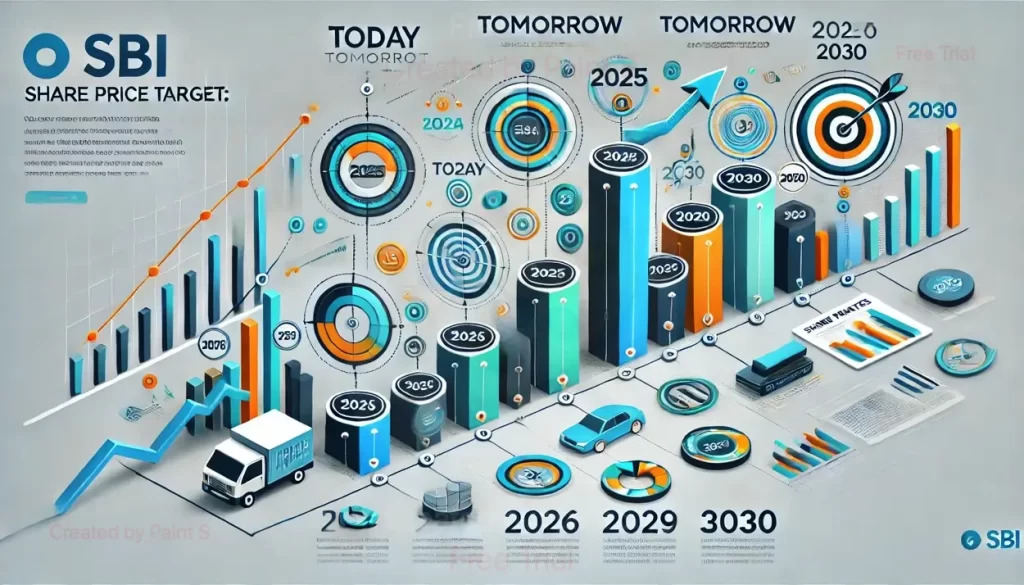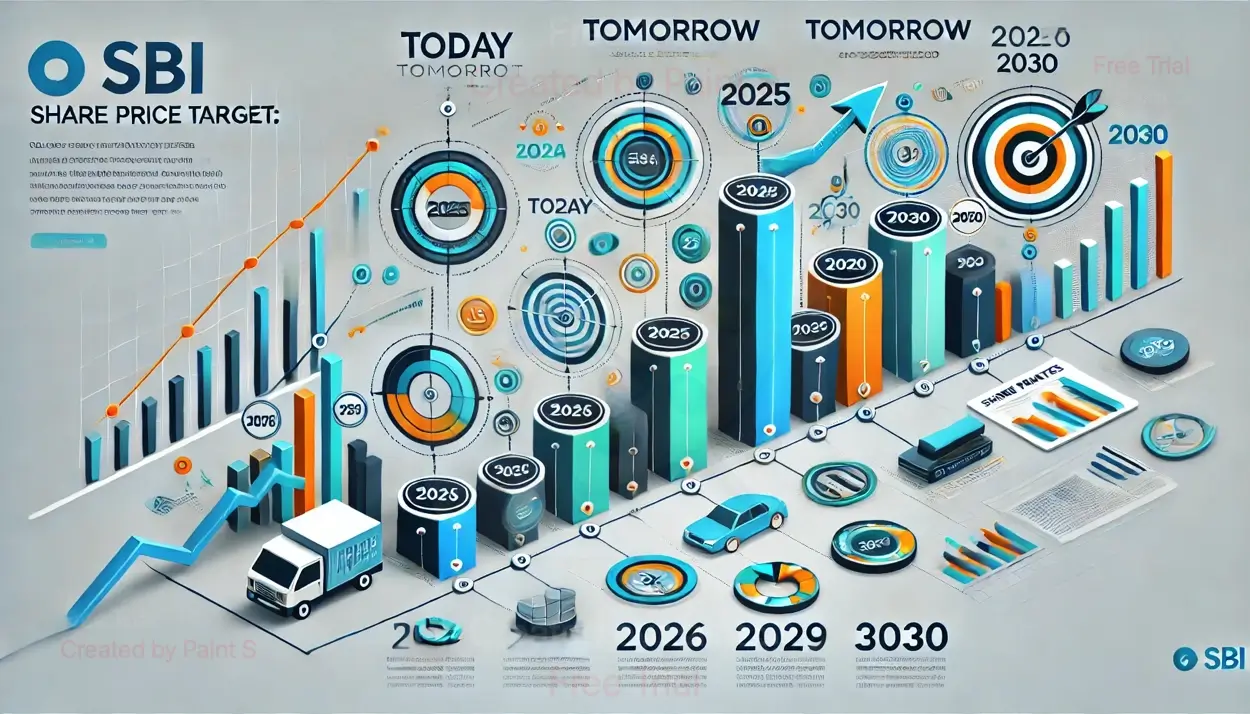SBI Share Price Target: State Bank of India (SBI), India’s largest public sector bank, is not only a leader in the banking industry but also one of the most bought stocks for investors. With a strong government backing, stable operations, and growth potential, SBI’s stock attracts the attention of both beginners and seasoned investors.
In this article,
We’ll analyze SBI’s share price targets for today, tomorrow, and each year from 2025 to 2030. Additionally, we’ll include views from 10 top brokerages to provide comprehensive insights.
#SBI Share Price Target for Today and Tomorrow
Predicting exact short-term prices is challenging due to daily market fluctuations. However, factors like market sentiment, global trends, and recent developments can help estimate short-term movements.
– Today’s Estimate
If positive sentiments prevail, SBI’s stock could see minor gains, reflecting its historical stability.
– Tomorrow’s Estimate
If the market stays consistent with no disruptive news, SBI may trade within a predictable range, following its trendline.
Short-Term Key Factors effecting SBI Share price
1. Quarterly results.
Quarterly results play a significant role in determining SBI’s share price target. If SBI reports strong earnings, improved asset quality, and growth in loan books, it can boost investor confidence, leading to a rise in the stock price.
On the other hand, weaker-than-expected results, such as higher bad loans or lower profits, may cause the stock price to fall.
Positive results attract more buyers, while poor results might trigger sell-offs, directly impacting short-term price targets.
2. Global interest rate changes.
Global interest rate changes can significantly affect SBI’s share price. When interest rates rise globally, it often leads to higher borrowing costs, which can reduce loan demand and slow down economic growth, potentially impacting SBI’s profits.
On the other hand, when interest rates are lowered, it makes borrowing cheaper, which can increase loan demand and boost the bank’s earnings, leading to a rise in its stock price.
Investors closely watch these changes, as they can influence SBI’s financial performance and its future share price outlook.
Read also: Bank of Japan’s Biggest Interest Rate Hike Since 2008: Will It Impact the Indian Stock Market?
3. News in the banking sector.
News in the banking sector can have a big impact on SBI’s share price. Positive news, such as government reforms, new banking policies, or SBI’s successful ventures, can boost investor confidence and lead to a rise in stock prices.
On the other hand, negative news, like stricter regulations, rising non-performing assets (NPAs), or issues with other banks in the sector, can lead to a decrease in stock prices. Investors often react quickly to such news, affecting short-term price targets for SBI.
SBI Share Price Target for 2025

By 2025, SBI is expected to consolidate its leadership in the Indian banking sector, benefiting from increasing financial inclusion, a growing economy, and its investments in technology.
Estimated Target Range for 2025: ₹800 to ₹1,000
– Why this
- Expansion of digital banking services.
- Increased loan demand in retail, corporate, and MSME segments.
- Consistent government reforms and economic growth.
Read also: Infosys Share Price Target (2025-2030): Quickly What You Need To Know Before Investing
#SBI Share Price Target for 2026
By 2026, SBI’s long-term strategies will begin to deliver more visible results. Its digital initiatives, cost optimization efforts, and focus on rural banking will likely drive profitability.
Estimated Target Range for 2026: ₹950 to ₹1,200
– Reason
- Reduced non-performing assets (NPAs) through better credit risk management.
- Steady growth in loan book and deposit base.
- Continued focus on digital transformation to reduce operational costs.
Read also: ICICI Bank Share price Target for today 2025 to 2030: Quickly What You Need To Know Before Investing
#SBI Share Price Target for 2027
As the Indian economy matures, SBI will be at the forefront of supporting infrastructure development and industrial growth. By 2027, it may also explore deeper global operations.
Estimated Target Range for 2027: ₹1,200 to ₹1,400
– **Growth Drivers:**
- Stronger demand for infrastructure and housing loans.
- Increased adoption of SBI’s digital banking platforms.
- Stable dividend payouts attracting long-term investors.
SBI Share Price Target for 2028
By 2028, SBI is likely to see its revenues driven by enhanced participation in fintech collaborations and strategic tie-ups, further cementing its position in the Indian banking sector.
Estimated Target Range for 2028: ₹1,400 to ₹1,700
– **Growth Drivers:**
- Advanced use of technology, including AI and blockchain, for better service delivery.
- Growing customer base in rural and urban regions.
- Increased foreign institutional investments (FII) due to stable performance.
Read also: Hdfc bank q3 results: What You Need To Know Before Investing Quickly
#SBI Share Price Target for 2029
As SBI reaches a near-monopoly in certain banking services, it is expected to grow its balance sheet significantly by 2029. Its global presence will also add to its valuation.
**Estimated Target Range for 2029:** ₹1,600 to ₹1,900
– Growth Drivers:
- Growing international operations.
- Increased partnerships with government schemes (e.g., credit-linked subsidies).
- Expanded product portfolio catering to all customer segments.
Read also: TCS Share Price: What You Need To Know Before Investing Quickly
#SBI Share Price Target for 2030
By 2030, SBI will likely be at its peak, benefiting from a fully digital banking ecosystem and a significant increase in banking penetration in India.
Estimated Target Range for 2030: ₹1,800 to ₹2,200
– **Growth Drivers:**
- India becoming the third-largest global economy, increasing banking demand.
- Lower costs and higher profits from digitization.
- Dominance in all banking verticals – retail, corporate, and rural.
### 10 Best Brokerage Views on SBI
Here’s what top brokerages have to say about SBI:
| Brokerage House | Target price | Time period |
|---|---|---|
| 1. Motilal Oswal | ₹900 | 1-Year Target |
| 2. ICICI Direct | ₹950 | 1 Year Target |
| 3. HDFC Securities | ₹1000 | 1 Year |
| 4. Kotak Securities | ₹1100 | 1 Year |
| 5. Axis Direct | ₹1200 | 2 Years |
| 6. Morgan Stanley | ₹1500 | By 2027 |
| 7. CLSA | ₹1,600 | By 2028 |
| 8. Goldman Sachs: | ₹1800 | 2030 |
| 9. Nomura | ₹1,700 | By 2029 |
| 10. JP Morgan | ₹2,000 | By 2030 |
#Should You Invest in SBI Shares?
1. For Long-Term Investors
- SBI offers consistent growth potential and is backed by strong fundamentals.
- Suitable for those looking for stable, long-term wealth creation.
2. For Short-Term Traders
– SBI is relatively less volatile but can still provide opportunities during earnings announcements or sectoral movements.
3. Risk Factors
- NPAs (bad loans) and economic slowdowns could impact its performance.
- Competition from private banks could pose challenges.
#Conclusion
SBI is a promising stock for both short-term and long-term investors. With its leadership in the Indian banking sector, strong fundamentals, and future growth potential, it is likely to deliver solid returns in the years to come. As with any investment, always conduct thorough research and consider your financial goals before investing.
If you’re planning for the long term, SBI shares could be a cornerstone of your portfolio, thanks to its stability and growth potential.






